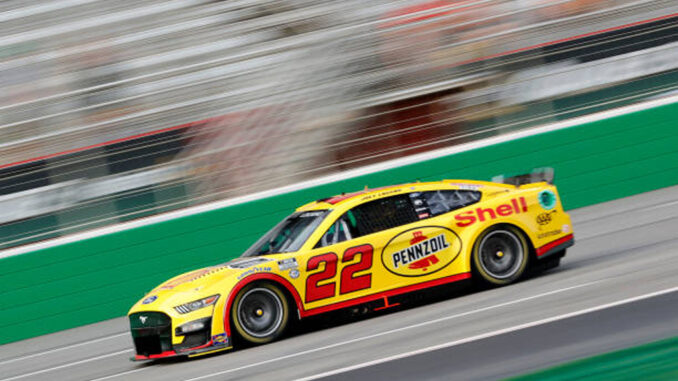
Track position was on plenty of drivers’ minds heading into qualifying at Atlanta Motor Speedway Saturday.
The Next Gen superspeedway package has made passing more difficult according to Joey Logano.
“The bottom line is it’s hard to pass,” Logano said. “It’s racing, though. That’s what racing is, it’s challenging and as our cars just run the same speed it’s going to be hard to pass.
“We used to have cars that were more separated, but now everybody is within a couple tenths of a second and dirty air is going to be more than that.”
And that forces drivers to run up front and abandon any conservative strategies.
“No matter what speedway it is, you just can’t afford to ride around in the back,” Corey Lajoie said. “You’ve got to have track position all day to be up front when the pay window is open and that takes a lot of risk.
“You have to weigh the risk versus reward at certain points in the race,” he added. “But a lot of the time you just don’t get the chance to maneuver because you’re so far back.
“It’s coming out here and racing to win it,” Chris Buescher added, “and understanding that. when you go speedway racing, there’s inherent risk in it.”
“It’s easier to get caught in someone else’s mistake and make a mistake of your own when you’re in just such a small window,” he admitted. “But we’re going to go out here and figure out how to lead every lap and be there at the end to win it.”
That’s especially true, Justin Haley pointed out, with the new era of stage racing.
“You’re going to race for stage points especially: I finished second last week and wasn’t even close to scoring as many points as seventh, eighth, or ninth place did, so stage points are huge.”
According to Ricky Stenhouse, reigning Daytona 500 champion, being up front presents gives options and control, with the risk actually being further back in the pack.
“I think at any of the superspeedways these days, you want to get track position and stay up front,” he said. “It’s hard to come through the field these days. For me, I would much rather be up at the front of the field, controlling the lines and controlling your own race.”
The Playoff picture is also a factor. Bubba Wallace sits just fifteen points to the good, meaning his position is precarious. To him, running up front all day is the best of both worlds, despite some risk of a wreck.
“You win, you’re in, I think that’s the important thing. But if we can’t get a win then we need to rack up as many points… got to have a good fallback plan,” he said.
For his part, Alex Bowman clarified that track position isn’t everything, and things can go wrong even with it.
“I think track position’s really important for sure, but equally playing the right strategy,” he pointed out.
“I mean, we had a really fast car in the spring here and we were the only Chevrolet among a bunch of other manufacturers and just got shuffled out without any help. So track position is key but you’ve got to have your help around you too.”
Finally, some drivers, like AJ Allmendinger, take a different approach altogether.
“I’m just going to pray like I always do at these races,” Allmendinger said. “I hate them.”
- Denny does Dover after surviving hard-charging Kyle Larson to tame the Monster - April 28, 2024
- The Monster Mile brings short track style to high banking - April 25, 2024
- Sam Mayer scores Xfinity win by an inch in photo finish at Texas - April 13, 2024